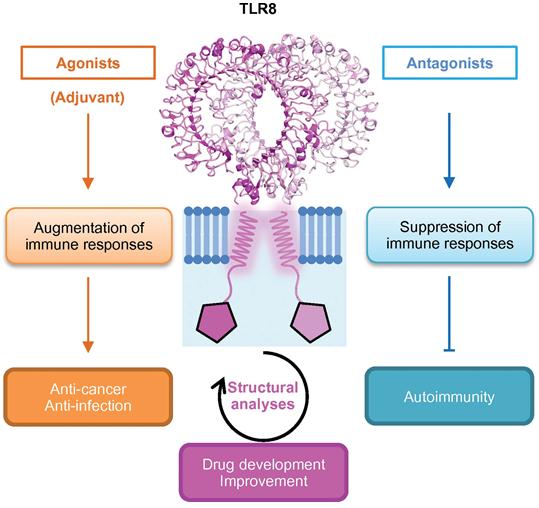
Our promise to you:
Guaranteed product quality, expert customer support.
 24x7 CUSTOMER SERVICE
24x7 CUSTOMER SERVICE
 CONTACT US TO ORDER
CONTACT US TO ORDER
TLR8 Gene Editing 
It is well known that Toll-like Receptor (TLR) signaling is a pathway leading to the differentiation of normal hematopoietic cells. TLRs are a key family of receptors related to inflammation. In humans, 13 TLRs have been identified that recognize pathogen-associated molecular patterns, resulting in the induction of proinflammatory cytokines and an immune response.
The genes encoding TLR7 and TLR8 are located in the X chromosome. TLR7 and TLR8 are phylogenetically similar and both can recognize single-stranded RNA and short double-stranded RNA, so their role in sensing different viral pathogens. It is known that TLR8 is mainly expressed in monocytes/macrophages and myeloid dendritic cells (DCs), while TLR7 is mainly expressed in plasmacytoid DCs and, to some extent, in B cells and monocytes/macrophages. Recent evidence shows that endosomal TLRs are delivered from the endoplasmic reticulum to the endosome through the endoplasmic reticulum-resident membrane protein UNC93B1. In the case of TLR8, UNC93B1 seems to be required not only for intracellular trafficking, but also for cell signaling. After activation by its cognate ligands, TLR8 is modified to yield species of different molecular mass, including a monoubiquitinated form which might act as a cell signal for trafficking in the endocytic pathway. Attachment of monoubiquitin to membrane proteins serves as a signal for internalization of the TLR into the endosome, which is the site of the active signal.
TLR8 As a Therapeutic Target
TLRs play an important role in the innate immune system, and they have become significant targets for the development of therapies in certain diseases. At present, many clinical trials investigating TLR ligands are in progress, and some TLR agonists have been approved. Because the innate immune system contains a mechanism to boost the adaptive immune system, TLR ligands are promising candidates for adjuvant therapy. Resiquimod (R848), a TLR7/8 agonist similar to imiquimod, is a good candidate in clinical trials. As a TLR8-selective agonist, VTX-2337, proposed to augment antibody-dependent cellular cytotoxicity by activating NK cells, has also been assessed in clinical trials. In addition to these examples, other novel compounds have been successfully characterized and reported as candidate adjuvants for targeting TLR8 or TLR7/8. IMO-8400 is a TLR7/8/9 ligand that is currently being studied for clinical application in the treatment of immune-mediated inflammatory diseases such as psoriasis. Impressively, IMO-8400 has been reported to be a first-in-class oligonucleotide antagonist that is proposed to inhibit aberrant TLR-mediated inflammation.
At the same time, the relationship between TLR8 and autoimmune diseases has received considerable attention, such as systemic lupus erythematosus and rheumatoid arthritis. Because TLR8 (and TLR7) senses and responds to various RNA viruses, TLR8 deficiency has been considered to cause viral infections; however, it has been reported that TLR8 deletion accelerates autoimmunity in mice. Recent studies have shown that TLRs influence neurogenesis, neurodegeneration and neuronal morphogenesis, indicating that TLRs are related to inflammation and neurodegenerative diseases such as Alzheimer's disease and Parkinson's disease. Although TLRs in the CNS may continue to demonstrate unknown functions, clarifying the mechanisms of these functions is an intriguing challenge, which will be beneficial for developing new therapies for CNS diseases.
 Figure 1. Application of TLR8 in disease treatment. (Sakaniwa K, Shimizu T. 2020)
Figure 1. Application of TLR8 in disease treatment. (Sakaniwa K, Shimizu T. 2020)
TLR8 Gene Editing Services
CRISPR/Cas9 PlatformCB at Creative Biogene is dedicated to offering comprehensive CRISPR/Cas9 gene editing services and products for academic research, biotech research and pharmaceutical drug discovery. With deep gene editing knowledge and extensive experience in experimental operation and data processing, we help you effectively control TLR8 genes knockout/knockin/point mutation in cells or animals via CRISPR/Cas9 technology.
| Service | Details | Alternative cell lines or animal species |
| TLR8 Gene Editing Cell Line Generation | gRNA design and synthesis Transfect the cell lines you're interested Select the high expression cells and sort monoclonal cell Validate the knockout/knockin/point mutation of TLR8 by PCR and sequencing Provide cryogenically preserved vials of stable cells and final reports | HEK239T, Hela, HepG2, U87, Ba/F3, CHO, MDA-MB-453, MDA-MB-231NIH3T3, T47D, Neuro2a, MCF7, RKO, K562, RAW264.7, etc. |
| TLR8 Gene Editing Animal Model Generation | TLR8 gene conventional knockout animals TLR8 gene conditional knockout animals TLR8 point mutation animals TLR8 knockin animals | Mouse, rat, rabbit, zebrafish, C. elegans, etc. |
Related Products at CRISPR/Cas9 PlatformCB
| CATALOG NO. | PRODUCT NAME | PRODUCT TYPE | INQUIRY |
| CCKM0881 | B6J-Tlr8em1Cd | Knockout Mouse | Inquiry |
| CDKM-0667 | B6J-Tlr8em1Cflox | Knockout Mouse | Inquiry |
References
- Sakaniwa K, Shimizu T. Targeting the innate immune receptor TLR8 using small-molecule agents. Corrigendum. Acta crystallographica. Section D, Structural Biology, 2020, 76(Pt 9): 905.
- Ignatz-Hoover J J, et al. The role of TLR8 signaling in acute myeloid leukemia differentiation. Leukemia, 2015, 29(4): 918-926.
- Cervantes J L, et al. TLR8: the forgotten relative revindicated. Cellular & molecular immunology, 2012, 9(6): 434-438.
- Liu X, Li L, Peng G. TLR8 reprograms human Treg metabolism and function. Aging (Albany NY), 2019, 11(17): 6614.